UEFA Supercup Preview: Bayern vs. Sevilla
A special evening will await the two teams of FC Bayern and Sevilla on Thursday, for several reasons. For one, the UEFA Supercup is not only about winning just another trophy, it is also about realizing what staging a mass event in a high-risk COVID-19 area like Budapest means. A maximum of 3,000 fans for both clubs, respectively, are allowed to enter the country to attend the game, and a total of 20,000 spectators are allowed into the stadium. Due to a recent surge in COVID-19 cases, Hungary has closed its borders for entry of foreign nationals since September 1 – the only exception being the Supercup final.
It is more than questionable whether this has been the right decision. Ultimately, staging a mass event in a coronavirus hotspot does not come without risks. In Germany, if a region surpasses a threshold of 35 new infections per 100,000 inhabitants within the last seven days, no matches may be played with fans present in the stadium in the Bundesliga in that region. In Budapest, the figure is around 100 (as of September 20 2020) – about twice as high as in Munich.
As is so often the case, only hindsight will show whether such concerns will have been valid. And yet, regardless of the outcome, the question must be asked whether football, having been given preferential treatment once again, is worth taking the risk in the first place.
FC Sevilla: The Europa League’s serial champions
Then there is the issue of the value of the European Supercup as a sporting competition. If you look at the games of the recent past, they were always entertaining and usually closely contested affairs at a very high level. On top of this, both FC Bayern and Sevilla surely would like to win the cup and add another achievement to their outstanding year.
For the Spanish side, the game effectively means the beginning of their season. It will be difficult for anyone to properly judge the European League winners’ form at present because their first two games against Atlético Madrid and FC Elche have been postponed. In terms of their squad, however, not much has changed. Éver Banega (32), a veteran of Spanish soccer, has left the club, but Sevilla was able to compensate for his departure with the signing of Ivan Rakitic (31), who returned to his old club for an initial sum of €1.5m plus additional potential bonuses after moving from Sevilla to Barcelona in 2014. The loss of Sergio Ruguilón (23) after the end of his loan could also be made up for, at least in theory, with the signing of Marcos Acuña (28). The Argentinean is fast, dynamic and versatile. He can be used in the left-back position and in midfield equally well.
They also made the loan of Suso (26), who had joined from AC Milan last winter, permanent for €24m. He has yet to prove his value, having scored only two goals and one assist in his 23 matches for the club so far. Also worth mentioning is the signing of Óscar Rodriguez (22) from Real Madrid for €13.5m. During his loan spell at Leganés, the attacking midfielder was able to show his quality at times and is now taking the next step by joining an ambitious club that enjoys a great deal of recognition in Europe.
There is strength in calmness
After all, Sevilla are the record winners of the UEFA Europa League and former UEFA Cup. The Spanish team has reached the final six times (2006, 2007, 2014, 2015, 2016 and 2020), having won six of them. Their opponents of the most recent final, Inter Milan, come in third place on this list, having won the cup three times. However, Sevilla only managed to win the European Supercup once – against Barcelona in 2006.
Sevilla plays a brand of football that is not only very typical of Spanish football culture, but also clearly bears the signature of the coach Julen Lopetegui. The 54-year-old attaches great importance to a controlled and well-organized build-up play based on a high level of passing accuracy. With 392.7 short passes per game, Sevilla was ranked third behind Real Madrid (458.4) and Barcelona (598.3) in the past La Liga season.
Lopetegui wants his team to play with patience. It helps in this that he has a squad at his disposal with a great deal of experience. Lopetegui’s maxim is that it is better to play one more backwards or sideways pass than to take too much of a risk going forward. On the other hand, Sevilla is able to develop a considerable threat in attack when they suddenly increase the pace.
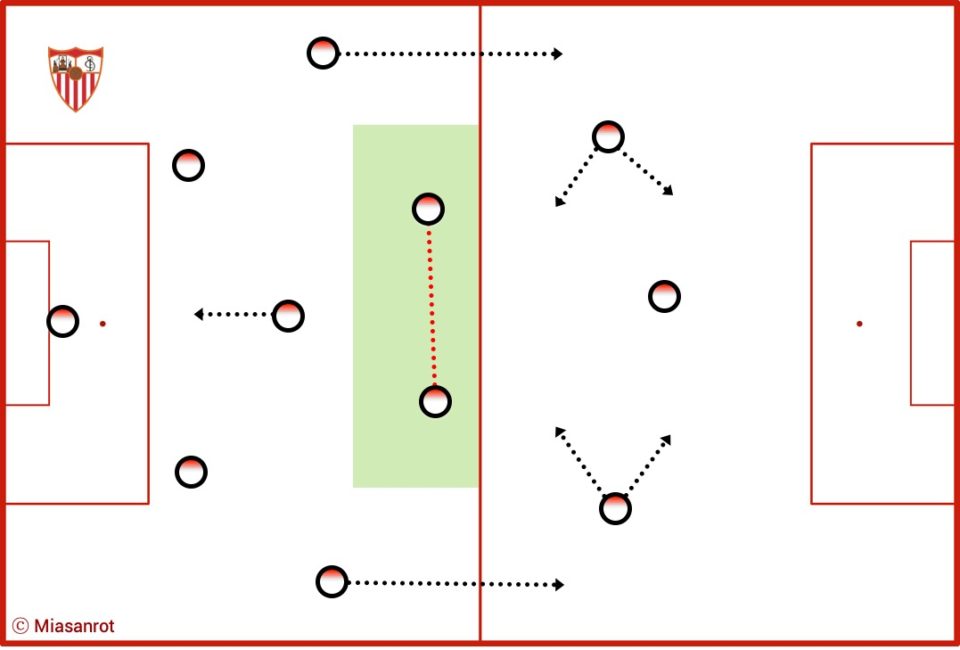
Sevilla’s positional play is characterized by typical 4-3-3 patterns when they are in possession: Very high full-backs who are protected by wide center-backs and a holding midfielder who often drops off, as well as wingers who tend to drift inside into the half-spaces in order to create space for the full-backs to push up and provide support in the center.
Problems in the final third
Especially the two central offensive midfielders carry a big responsibility in Sevilla’s game. Sevilla, at their core, are a very wing-focused outfit, but their midfielders are the players tasked with calming down the game to provide moments of reprieve when needed, as well as speeding it up in oder to spring a surprise on the opponents’ defense when the opportunity arises. Over the course of last season, the offensive midfielders were occasionally unable to properly link up their team’s build-up play from the back with the attacking third. Sometimes they were too low, and opponents who were pressing high – as FC Bayern will be tonight – could not be overplayed because Sevilla’s players were closely marked or crowded out, while the distance to the top was too long as the same time.
This should greatly favor Bayern, who will probably be able to force turnovers and create a sudden goal threat if Sevilla exaggerates their tendency to move the ball around at the back. If the two offensive midfielders are forced to drop back, the game of the Spaniards lacks the necessary depth for dangerous attacks.
In attack, Sevilla usually lacks the capacity to spring a surprise, especially against well-organized defensive lines. They typically move the ball around well, but then struggle to find spaces due to their rather sluggish possession game and because they lack a player able to make a difference in the final third. Lopetegui has not yet found the right way to make the controlled play of his team less predictable. Paradoxically, it is at the same time one of the team’s great strengths that they have ball control and can make smart decisions under pressure, while it is also one of their great weaknesses that they find it very hard to speed up the game and gain momentum from a languid pace.
Bayern’s first real test?
Thursday evening will be particularly interesting because Sevilla will not need to create spaces or find gaps in Bayern’s defense. Instead, they will have to force the Champions League winners to lose the ball as often as possible. Sevilla will probably approach this endeavor out of a mid block. This will allow Lopetegui’s team to retain the capacity to push up quickly as well as to fall back into a compact defensive shape and sit deep when there is no prospect of winning the ball.
If Bayern lose the ball, Sevilla have two options: Either they opt for a direct counter-attack via the fast wingers through the half spaces, or they try to keep the ball in order to trigger Bayern’s immediate gegenpressing. Of course, inviting Bayern to aggressively press their opponents is always a risk, but Sevilla have the technical and tactical qualities to be able to overplay Bayern’s press and thus create promising overloads in the final third.
Nevertheless, Bayern are still in outstanding long-term form. Since Hansi Flick has arrived, they have reached perfection in so many tactical aspects of the game that any opponent in the world would have problems. There are clear, recurring sequences in the treble winner’s game, and yet the opponents struggle heavily to adjust to them, because, for one, Bayern’s execution is so incredibly precise and sharp that opponents often have no chance although they know what is coming, and, second, there are minute differences to each of Bayern’s plays although it often feels as though you have already seen it all before.
Situation analysis: Bayern’s sixth goal against Schalke
A quite simple example, which explains several principles at work at Bayern in a nutshell, is this situation from the 69th minute of the match against Schalke.
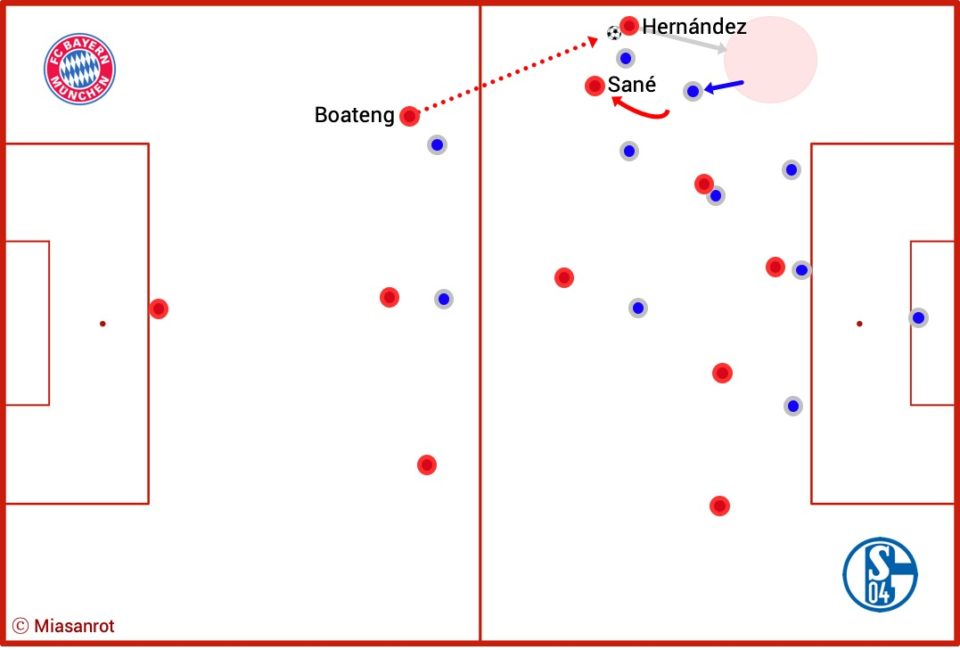
Boateng builds up with a pass to Hernández, because he sees that Sané offers his support in the half space. This pass is not without risk, because Schalke would have quite a lot of space to exploit ahead of them if they were able to win the ball. But it also offers the theoretical chance to create a lot of space on the other hand. Sané’s movement draws out Schalke’s full-back, giving Hernández the chance to play a one-two. However: The Bayern players probably realize intuitively in this situation that their attacking players are not optimally positioned and a breakthrough could lead to a loss of the ball, especially because Sané would have to play a very demanding ball to reach Hernández. Consequently, Hernández plays the ball back to Boateng.
Nevertheless the situation shows the basic principle of half-space support. Both the wingers and the midfielders try to open up passing lanes from the wings to the center or in the half spaces by moving cleverly between the lines and drawing opposing defenders out of position after the full-backs have initiated build-up play. There is a constant flow of movement in which each player knows exactly what he has to do at what point in time. Of course Bayern have to find solutions intuitively on the pitch, but Flick seems to want to leave little to chance. His players’ running paths and patterns seem to be thoroughly planned and prefigured. As such, they are representative of Flick’s conceptual love of detail.
The situation continues with a shift of the play across by Boateng.
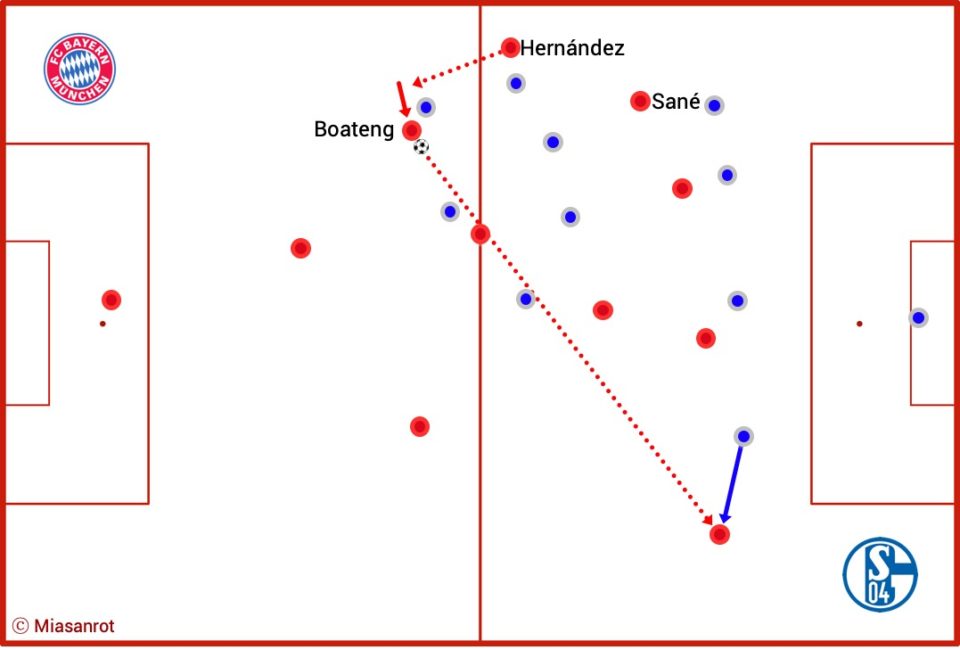
Here, Schalke’s Bastian Oczipka decides to shift out quickly, Bayern win a throw-in. Despite the play not coming off, this scene is indicative of another principle in Bayern’s game, too. Against Schalke they attempted a lot of switches of the play across to enable Gnabry, Sané or the full-backs to move into promising positions. In this example Schalke have closed the left wing where, as a result, Bayern are clearly outnumbered. Bayern thus have successfully induced Schalke to shift out and their task now is to find a solution to use the concerted sideways movement of the blues to their advantage. The switch across was meant to do this. But since Gnabry is not wide enough, Oczipka manages to close him down in time and clear the ball for a throw-in. Schalke uses the gained time to fall back into an orderly shape.
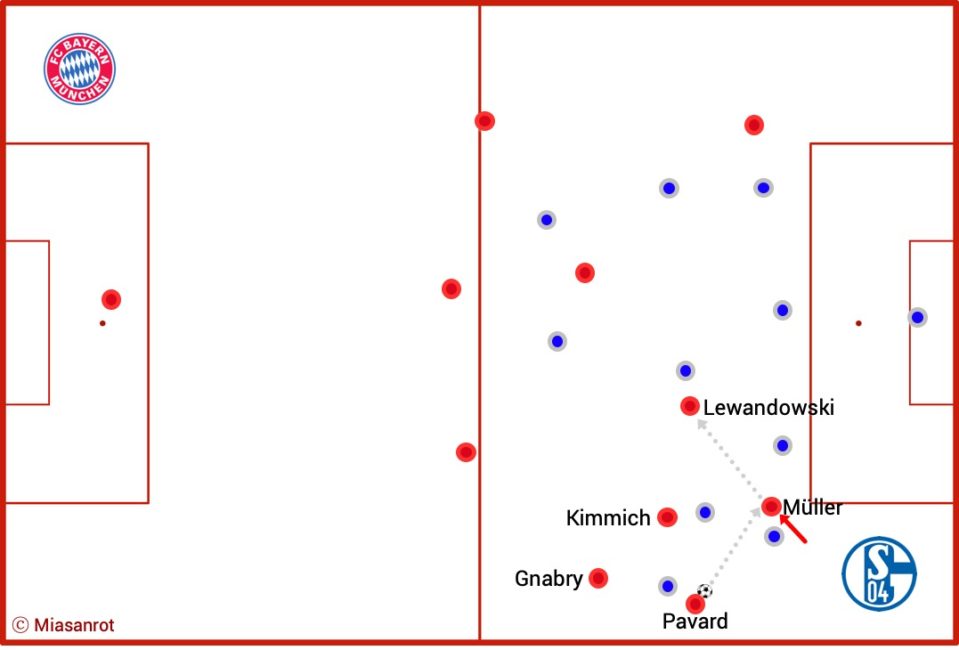
After the throw-in, Bayern quickly take up a flexible positioning which allows them to launch an attack, should they regain possession immediately, or initiate their gegenpressing if they do not. They position themselves in triangles and diamonds with three players securing the way back, and Kimmich and Gnabry standing ready to pounce close to the ball in case the ball is lost. Müller with a clever movement enables Pavard to reach him with a diagonal pass between the lines. At the same time, Müller also has a passing option available through the positioning of Lewandowski. Within seconds, Bayern spread out in a pattern that gives them all sorts of possibilities. Pavard, however, does not use the first available option to move the game forward, but plays the ball back again. He might have noticed that the passing options after Müller’s pass to Lewandowski would not be too promising. Instead, Pavard moves the ball on to Gnabry, who immediately finds Kimmich, who decides to play the ball back to Süle, who restarts his team’s build-up play. Despite the decision not to attack, the two principles of continuous half-space support and always being able to launch into gegenpressing close the ball are visible here throughout the entire passage of play. A perfect combination of depth, calculated risk and protection.
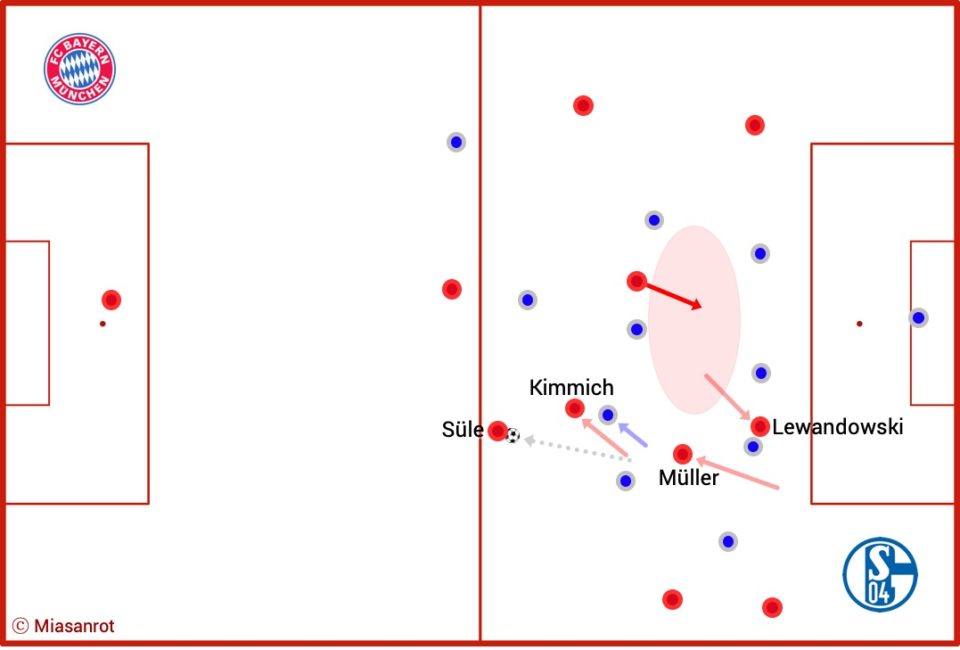
By liberating themselves out of this tight situation, Bayern force Schalke to stretch out vertically and offer space between the lines. Süle immediately drives forward with the ball in possession, Kimmich opens up a passing lane for him with his movement and Müller offers himself as a passing option in the space between the lines. At the same time, Tolisso, with a good deal of foresight, moves into the area marked in read between the opponent’s defensive lines, while Lewandowski also expects what is probably going to happen and runs into the penalty area. One could call this recurring principle “coming and going”. Bayern are always busy executing opposing movements. Some players make deep runs in order to push the opponent’s defensive line backwards, while others move between the lines to use the resulting space. There is no fixed assignment of roles in the sense that it would be always Müller for instance who dropped off. But Bayern almost always manage to be well coordinated and organized and so misunderstandings almost never occur.

Continuing with our example, Lewandowski is now free between the second center-back and full-back Oczipka, who is trying to close him down coming in from the wing. Meanwhile, Schalke are not fast enough to keep up with Tolisso’s sudden advance. Three players focus on Müller, who has enough time to play the pass to Tolisso.
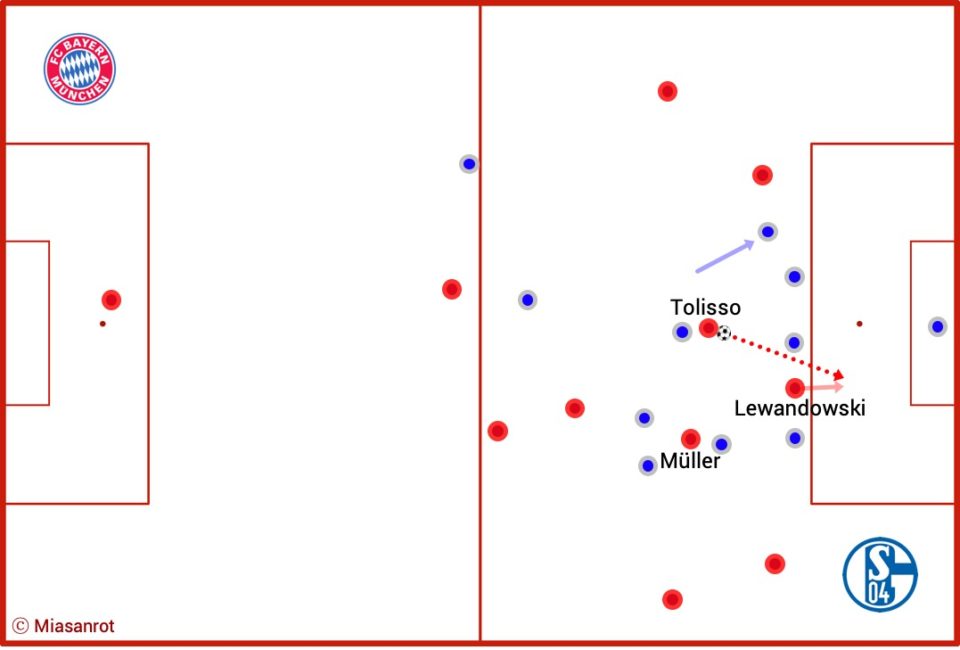
Tolisso is mentally switched on and directly puts the ball through to Lewandowski who now has a free path on goal on the inside right lane. Uncharacteristically, the Polish striker misses his moment to finish, but with an eye-catching Rabona he manages to set up the advancing Müller, who converts for 6-0. This is another sensational quality of Bayern’s game: Although Lewandowski fails to use a clear goal scoring opportunity from a free position, the team manages to get three players in a cleverly spread out pattern in the middle of the penalty area in an instant.
Can FC Bayern be stopped?
Bayern play with an unbelievable pressure and precision, which is exceedingly difficult to defend against. And even though Schalke have practically invited them to rout them at times, it is impressive how consistently Bayern follow their principles without becoming predictable.
Against Sevilla, this quality will be key to success, too. Besides that, Bayern’s ability to guard against counter-attacks will probably come into focus as well. Sevilla is more poised and composed on the ball than Schalke and can perhaps make use of situations which Schalke were not able to use. Occasionally, Schalke had the chance to hit Bayern, approaching their back line in 3-against-2 situations, but were unable to play the situation out, because Bayern have improved in moving back quickly, but also because Schalke simply did not have the quality.
Nevertheless, Sevilla will be a different proposition than Schalke, everyone agrees. But who can stop Bayern if they act with such flexibility and at such a high speed? In the long run, their chief competitor might just become their thin squad, if it is not significantly bolstered soon. But the situation we have analyzed above also shows that Bayern are able to use their spells in possession to recover if necessary. In the past, there have been moments when Pavard would only have had attack on his mind right after the throw-in. Instead, in this case, he chose the slower, less strenuous option, which ultimately did for Schalke just the same and thus proved to be the right one.
Detractors might say that the season for FC Bayern will not really get underway until Thursday night. Be that as it may, it will be interesting to see how the treble winners will present themselves in tonight’s game. The performance against Schalke might have to be evaluated in a new light after that.



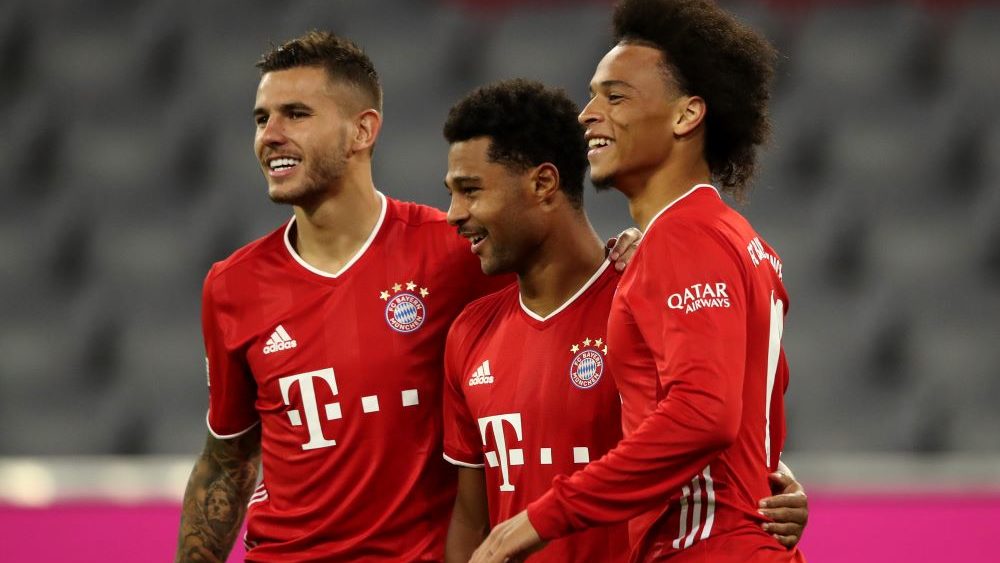








Brilliant analysis.